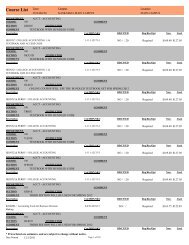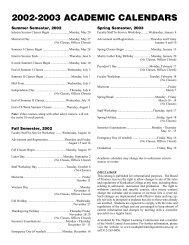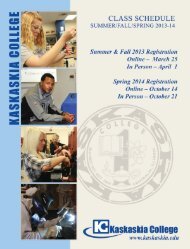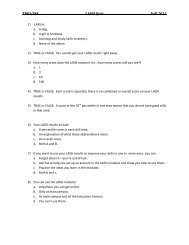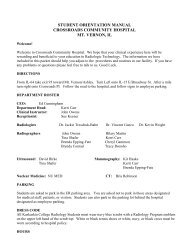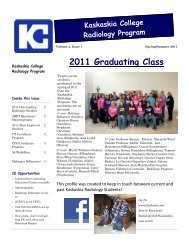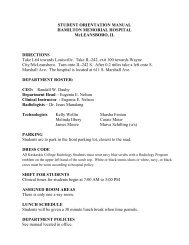Kaskaskia college registration
Kaskaskia college registration
Kaskaskia college registration
Create successful ePaper yourself
Turn your PDF publications into a flip-book with our unique Google optimized e-Paper software.
FINANCIAL AID SATISFACTORY ACADEMIC PROGRESS (SAP) POLICY<br />
I. Authority<br />
In accordance with the U.S. Department of Education and State of Illinois student aid regulations, <strong>Kaskaskia</strong> College (KC) is required to establish<br />
minimum standards of Academic Progress to qualify for federal and state financial aid. The purpose of the policy is to ensure that students are<br />
making progress toward the completion of their educational program of study. Students who do not attend or withdraw from classes, defer grades<br />
and perform poorly will not maintain satisfactory academic progress toward completion of their program of study and will become ineligible for<br />
financial aid. Minimal standards are subject to change in accordance with the U. S. Department of Education and State of Illinois regulations.<br />
II. Financial Aid Programs Covered<br />
The Satisfactory Academic Progress (SAP) policy applies to students who are requesting or receiving funds from federal and state financial aid<br />
programs.<br />
III. Minimum Academic Standards Requirements<br />
The SAP policy measures a student’s academic progress in three ways. Students must meet all three standards to be in good status.<br />
A. Cumulative Grade Point Average<br />
You must achieve and maintain at least a cumulative grade point average of 2.00 in all credit hours attempted at KC including transferred credits.<br />
B. Cumulative Completion Rate (CCR)<br />
KC’s CCR measures the pace a student is progressing through his/her program. Each student must pass a minimum of 67% of program required<br />
courses attempted to ensure the student will complete the program within the maximum time frame. The CCR is calculated by taking total credit<br />
hours earned and dividing them by total credit hours attempted. The CCR is calculated for each student after each semester. A students GPA and<br />
pace is affected by course incompletes, withdrawals, repetitions or transfers of credit. For CCR purposes all hours are counted for all terms, even<br />
those for which the students did not receive financial aid as well as those usually waived under Academic Renewal Policy. The only courses that<br />
will be used to calculate the CCR are courses as follows:<br />
1. Courses that are a required for the students program with a grade of ‘A’, ‘B’, ‘C’, or ‘D’<br />
2. All accepted transfer credits<br />
3. Remedial coursework is accepted if the credit hours earned apply toward the degree or certificate program and no more than 30 credit hours<br />
will be allowed for financial aid benefits. Grades of ‘I’, ‘W’ or ‘F’ are not considered completions.<br />
C. Maximum Time Frame<br />
You must complete your program of study within 150% of attempted credit hours relative to credit hours required to complete the program.<br />
Example: A degree-seeking student may attempt no more than 90 credit hours in order to complete a 60 credit hour program; a certificate-seeking<br />
student may attempt no more than 45 credit hours to complete a 30 credit hour program.<br />
Note: If during the SAP review it becomes clear that you cannot mathematically complete your program within the maximum time frame, you<br />
become ineligible for financial aid.<br />
IV. Frequency of Evaluation<br />
The SAP of degree-seeking and certificate seeking students will be evaluated at the end of each semester: fall, spring and summer. After each<br />
semester, students will be placed in the appropriate status as outlined in Section V.<br />
V. Initial, Satisfactory, Warning, Suspension and/or Maximum Time Frame and Probation Status<br />
A. Initial Status: Students who have no academic record at the College and are applying for financial aid for the first time are placed in initial<br />
status. Students in initial status may receive financial aid if otherwise eligible.<br />
B. Satisfactory Status: Financial aid applicants who meet the standards in Section III are in satisfactory status. Students in satisfactory status<br />
may receive financial aid if otherwise eligible.<br />
C. Warning Status: When financial aid applicants are in satisfactory status and do not meet the standards in Section III, they are placed in<br />
warning status. Students in warning status may receive financial aid if otherwise eligible.<br />
D. Suspension Status and Maximum Time Frame Status: When financial aid applicants who are in warning status do not meet the standards in<br />
Section III, they are placed in suspension or maximum time frame status and are not eligible to receive financial aid.<br />
E. Probation Status: When financial aid applicants who are in suspension and/or maximum time frame status submit an appeal and the appeal<br />
is granted, they are placed in probation status for one semester.<br />
If after that semester the student does not meet the standards in Section III, they become ineligible to receive financial aid. Students in<br />
probation status may receive financial aid if otherwise eligible.<br />
Note: Students who have an academic record at the College, including transferred classes, and are applying for financial aid for the first time at the<br />
College will be evaluated according to the SAP policy in Section III and placed in the appropriate status.<br />
77



